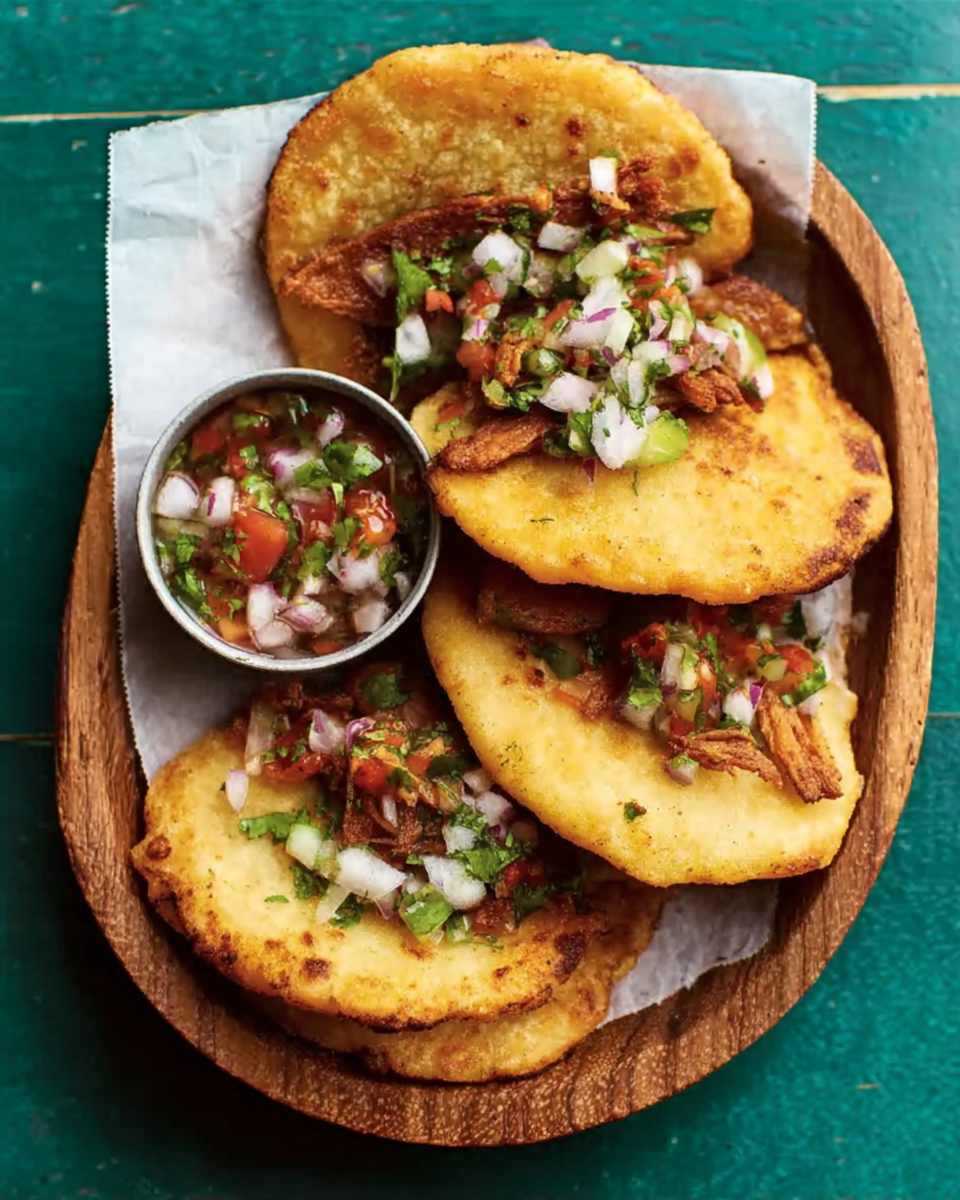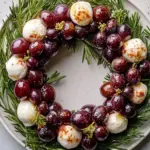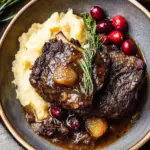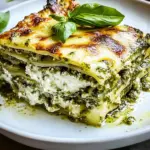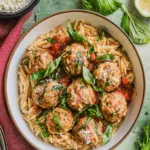These Gorditas de Chicharrón are a true staple of Mexican street food, especially loved throughout Central Mexico. With a crispy fried masa shell and a juicy filling of seasoned pork cracklings, each bite bursts with flavor and texture. Finished with traditional toppings like chopped onion, cilantro, and crumbly cheese, they’re the perfect balance of rich and refreshing.
Whether you’re looking to recreate a nostalgic snack or simply try something new and incredibly tasty, these gorditas are a must. They’re easy to make at home and pair beautifully with your favorite salsa or hot sauce. Perfect as a snack, lunch, or light dinner — they’ll quickly become a favorite!
Full recipe:
Ingredients:
-
1¼ cups tortilla masa
-
1⅔ cups nixtamalized corn flour (masa harina)
-
¾ teaspoon baking powder
-
1 teaspoon salt
-
Enough water to form dough
-
150 g (5.3 oz) pressed pork cracklings (chicharrón prensado)
-
2 tablespoons pork lard
-
Finely chopped onion to taste
-
Finely chopped cilantro to taste
-
Grated fresh cheese to taste
Directions:
-
In a large mixing bowl, combine the tortilla masa with the corn flour, baking powder, and salt. Gradually add water until the mixture forms a smooth, pliable dough.
-
Divide the dough into 4 equal portions and roll into balls. Flatten each ball slightly and press a cavity in the center.
-
Fill the cavity with chicharrón prensado, then carefully close and reshape into thick discs about 1 cm thick.
-
In a skillet over medium heat, melt the lard. Fry each gordita for about 2 minutes per side, or until golden and cooked through.
-
Remove and drain on paper towels.
-
Slice each gordita horizontally and stuff with chopped onion, cilantro, and grated fresh cheese. Serve hot and enjoy!
Prep Time: 10 minutes | Cooking Time: 10 minutes | Total Time: 20 minutes
Kcal: ~280 kcal per serving | Servings: 4 servings
The Importance of Masa in Mexican Cuisine
To understand gorditas, one must understand masa. Made from nixtamalized corn, masa is the foundation of many essential Mexican foods—tortillas, tamales, sopes, and of course, gorditas. Nixtamalization is an ancient process in which dried corn is soaked and cooked in an alkaline solution, then hulled and ground to form a dough that’s flavorful, pliable, and nutritionally enhanced. This method dates back thousands of years to pre-Hispanic civilizations such as the Aztecs and Mayans.
In gorditas, masa provides the soft yet sturdy structure needed to hold fillings and withstand frying. The result is a rich, earthy flavor with a slightly crisp exterior and a tender, chewy interior. Gorditas made from fresh masa taste remarkably different from those made with store-bought flour or cornmeal, highlighting the importance of preserving traditional techniques in modern cooking.
What Makes Chicharrón Prensado So Special?
Chicharrón prensado, the core filling of this recipe, is not just pork skin or fat—it’s a mixture of pork bits, skin, meat, and fat that have been cooked down with chili sauce until soft, flavorful, and slightly crispy. The term prensado refers to how the mixture is pressed into flat cakes or blocks to preserve it and intensify its flavor. Once cooled, it is sliced or chopped and used as a hearty and flavorful filling.
In gorditas, the chicharrón adds a punch of umami, richness, and satisfying chew that complements the soft masa and crispy exterior. It’s seasoned with mild or spicy chiles, onion, garlic, and sometimes tomatoes, depending on regional preferences. Because chicharrón prensado is often already cooked and seasoned, it makes for a quick and convenient filling option that packs immense flavor in every bite.
Cooking Techniques: Frying and Stuffing
What sets gorditas de chicharrón apart from other masa-based snacks is the combination of frying and stuffing. First, the dough is formed into small discs, filled with chicharrón, sealed, and gently flattened. They are then fried in lard or oil until golden brown. The use of pork lard (manteca) is traditional and contributes to a deep, savory flavor, though vegetable oil may be used for a lighter version.
The frying process results in a crisp crust on the outside while keeping the inside soft and steamy. Once cooked, the gorditas are sliced open like a pita and filled again with toppings. This double-stuffing approach adds contrast and textural balance—warm, hearty filling inside, and fresh, cool garnishes outside. The combination of techniques ensures that every bite is layered with complexity and richness.
Serving Suggestions and Customizations
Gorditas de Chicharrón are incredibly customizable and can be tailored to suit different tastes and dietary needs. Traditional garnishes include chopped white onion, fresh cilantro, and crumbled cheese—typically queso fresco or cotija. Some variations include shredded lettuce, pickled jalapeños, crema, avocado, or even a spoonful of salsa roja or verde for added spice and tang.
For a healthier twist, gorditas can be baked instead of fried, though this changes the traditional texture. Vegetarian versions may use beans, mushrooms, or rajas (roasted poblano strips) as the filling. Vegan gorditas swap out lard for vegetable shortening and omit dairy-based toppings. Regardless of the version, gorditas maintain their characteristic heartiness and comfort-food appeal.
When serving gorditas, they can be paired with a side of nopales (cactus salad), arroz rojo (Mexican red rice), or frijoles refritos (refried beans) for a complete meal. A chilled Mexican beverage like agua de jamaica (hibiscus tea) or horchata (sweet rice milk) also complements the bold flavors of the dish.
Gorditas in Everyday Mexican Life
Beyond being a popular street food, gorditas play a central role in family gatherings, local markets, school lunches, and weekend breakfasts. They are often made in large batches and shared communally, emphasizing the Mexican value of convivencia, or shared time with family and friends. Whether enjoyed from a roadside vendor in Puebla or at a home kitchen in Zacatecas, the gordita evokes a sense of nostalgia, warmth, and cultural pride.
Many home cooks have their own family recipes, passed down from mothers and grandmothers. These recipes may include special spice blends or filling techniques unique to each household. While gorditas may seem simple, they embody the complexity and depth that defines Mexican cooking—balancing tradition, flavor, and practicality.
In modern urban centers, gorditas are also gaining popularity in gourmet interpretations, with upscale restaurants experimenting with fillings like duck confit, mole, or smoked seafood. This adaptability shows how gorditas can bridge traditional and contemporary cuisine, preserving cultural heritage while embracing innovation.
Conclusion
Gorditas de Chicharrón are a perfect representation of the soul of Mexican cooking—humble ingredients transformed into something deeply flavorful, satisfying, and meaningful. From the earthy masa to the bold chicharrón filling, every element of the dish speaks to Mexico’s culinary ingenuity and cultural richness. Whether served on a bustling street corner or a family kitchen table, these golden discs of joy bring people together and tell a story of tradition, resilience, and flavor.
More than just food, gorditas de chicharrón are an edible piece of history, a sensory experience, and a reminder that the most comforting dishes are often the simplest. By learning how to make them and understanding their origins, anyone can take part in celebrating and preserving one of Mexico’s most beloved culinary traditions.

